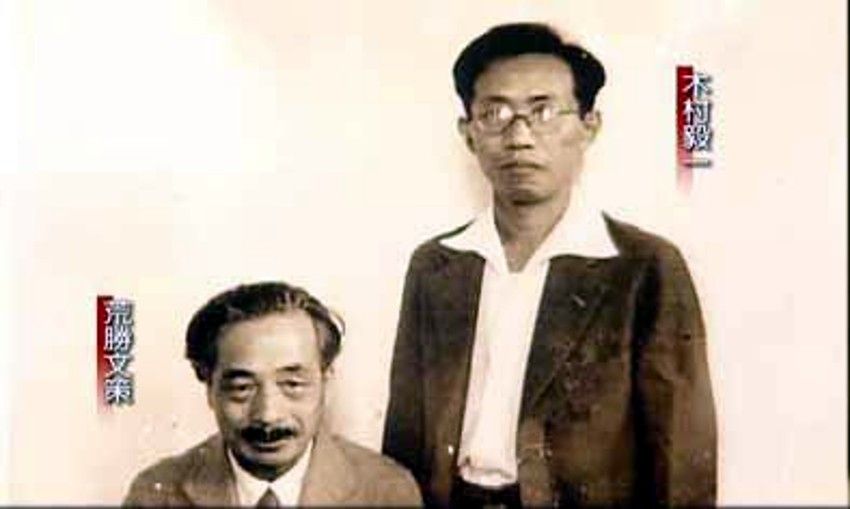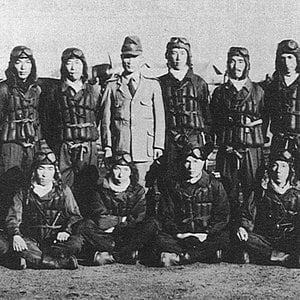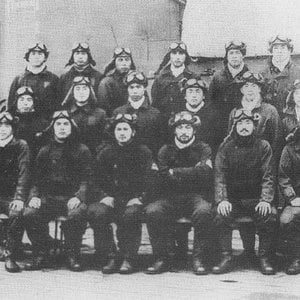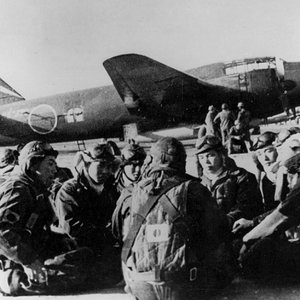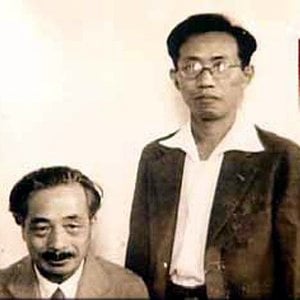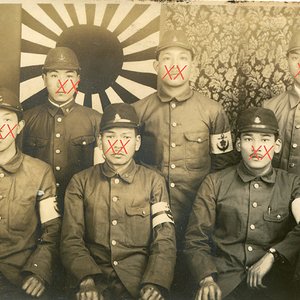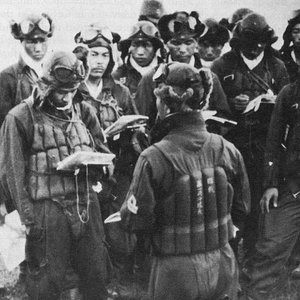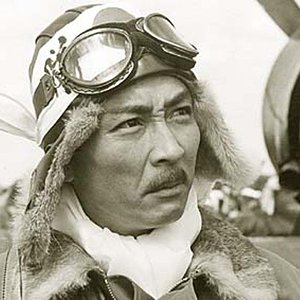Navigation
Install the app
How to install the app on iOS
Follow along with the video below to see how to install our site as a web app on your home screen.
Note: This feature may not be available in some browsers.
More options
You are using an out of date browser. It may not display this or other websites correctly.
You should upgrade or use an alternative browser.
You should upgrade or use an alternative browser.
Go Navy Project
The Imperial Japanese Navy (IJN) decided to create it’s own Atomic bomb project in 1943. Known informally as the Kyoto Group, IJN funded a team around the maverick scientist Prof Arakatsu with 600,000 yen in March 1943.
The Imperial Japanese Navy (IJN) project to enrich Uranium 235 was led by rear Admiral Nitta Shigeru. Nitta worked closely during early stages of the project from 1942 to 1944 on isotope separation with Sakae Shimizu . Dr. Shimuzu developed F-Go’s gaseous Uranium centrifuges.
IJN’s centrifuges were developed by a company specialised in precision ship gyros, Hokushine Electric Company with assistance from Tokyo Keiki Electric Co. These were built under contract by heavy engineering firm Sumitomo. Centrifuges were constructed from Rare earth metal alloys and spun at between 100,000 to 150,000 RPM. [9]
This was an impressive speed since even today the best centrifuges only operate at about 50,000 RPM. The measure of efficiency for any centrifuge at enriching Uranium depends upon the speed at which the centrifuge spins. It has been claimed that these centrifuges were never built, but the revolution could not be known without testing of an actual prototype machine. The biggest hurdles for any centrifuge are in creating bearings and rotor drums able to withstand the enormous forces involved. the earliest rotors used aluminium rotors, Subsequently maraging steel construction allowed even higher speeds, but the Japanese used alloys with Rare Earth metals to create exceptionally strong rotor drums. The Nazis developed carbon fibre brushes and may have shared these concepts with Japan.
Prof Arakatsu seated with Dr Kimura standing
Leading nuclear theorists for the Naval A-bomb were Professor Arakatsu Bunsuku, Dr Sugimoto Asao, Dr. Yukawa and Dr. Kobayashi. Heavy water was harvested by two heavy water plants, one in Kyushu and another at Noguchi’s JNFC-Nitchitsu Fertiliser factory in Korea. Heavy water was harvested as a by-product of Amonia Production for explosives. Noguchi is now a company known by the name Shoji Kamata. Heavy water was used by F-Go in a nuclear reactor project about which there is little publicly available evidence, except post war claims by Prof. Arakatsu. [10]
It is not known whether Japan’s reactor built at Kyoto worked successfully, or managed to breed any Plutonium. All wartime archives are now controlled by the Japanese Government which is under no obligation to disclose them.
An interesting point emerges however that A.H Compton’s investigation report for the Manhattan Project notes that Japan made far more progress in the field of developing nuclear energy than Germany did. [11]Uranium Acquisition
Most of the Navy’s Uranium-oxide at first was captured from the Chinese Navy’s stockpile at Shanghai and also from ceramics factories where it was used in glazes. Captured Ore was collected for Radio Chemists Dr. Sasaki Koji and Dr Okada Shinzo by Commander Iso Megumi, or his assistant Captain Mitsui Matao from naval ordinance at Kure. Uranium ore was then sent to Dr Okada. Naval liaison with scientists at Kyoto University was led by Lt. Cmdr. Kitagawa Tetsuzo. [12]
From March to May 1944 Uranium procurement for F-Go was taken over by Lt. Cmdr. Ishiwatari Miroshi. Kyoto University geologist Takubo Jitsutaro was employed by Japan Nitrogen Fertilizer Company (JNFC, also called by its Japanese name, Nitchitsu) to survey Manchuria and Korea looking for Uranium Ores.
The Imperial Japanese Navy found Uranium Ores in the hills above Konan, present day Hungnam. Ores were assayed under direction of Kyoto University’s Physicist Dr Kumura Kiichi. Commencing between 1915-1916 the Riken was set up by the Japanese Government to exploit private investment in public owned research facilities. Private companies were encouraged to back specific scientists to create specialist laboratories and in return could reap private rewards. [13]
Before the war JNFC-Nitchitsu had created a major plant to export fertiliser to the Soviet Union. This plant also had the industrial capacity meet Japan’s need for nitrates used in wartime for explosives. JNFC-Nitchitsu therefore leveraged it’s huge supply of industrial hydroelectric power and ability to produce Heavy Water in it’s Hungnam fertiliser plant, by funding another vital wartime project.
JNFC-Nitchitsu recruited massed labourers, both Japanese, Korean and Manchurian nationals to conduct mineral sample surveys. Japanese authorities lined up thousands of Korean workers to walk, side by side, over Korean hills in search for outcrops of mineral ores which might bear radioactive elements. Even the smallest deposits were dug out, by hand if necessary. Likely findings were spirited away to JNFC-Nitchitsu for analysis. Ten significant sites bearing Fergussonite were located producing in excess of 500,000 tons of radioactive ores. These ores were shipped to Wonsan in Korea for refining to oxide and then to Konan for reduction to metal.[14] The entire project was conducted on the same scale as Manhattan’s Oak Ridge facility.
F-NZ Project
In June 1944, 308,488 Yen in funding were released via the Army Aviation Bureau for development of a nuclear weapon for the purpose of aerial attack against USA. It was given the cover name for funding purposes Kokudoryoku Keikaku (Project Aeropower). This project appears to have been the founding of F-NZ. Later on 6 December 1944 a further one Million Yen were released for this project. It is this project which seems to have amalgamated with efforts by the Japanese Navy.
F-NZ, or “ENNUZETTO,” was a secret joint services project led by Admiral Hasagawa Hideo. Captain Mitsui was also involved with the ultra secretive F-NZ laboratory at Konan. [15] F-NZ was said to be a joint forces amalgamation of efforts by the previous Nishina Project and the Kyoto project. It has also been associated with General Kawashima and the 8th Imperial Army Laboratory in Korea. The relationships between these organisations remains unclear.
The history of F-NZ is less clear and only came to light from the escape from North Korea of Chemical Engineer Otogoro Natsume in October 1946. This forced US Army Intelligence to re-open investigation of the Japanese Atomic bomb project. Earlier in August 1945 the OSS had parachuted into Korea just one day after the formal signing of a peace agreement aboard USS Missouri. This had led to a clash with the Manhattan Committee which wanted to keep the Japanese Atomic bomb project secret. Part of this desire appears founded on a secret agreement with the Japanese for USA to acquire all research details from Unit 731 and from Japanese nuclear projects. This was highlighted in 2002 when documents about the Japanese A-bomb project were returned to the Japanese Government, which refuses to make them public. Immediately following Japan’s surrender the American military Government in Japan, SCAP exercised draconian powers of censorship to silence Japan’s scientists about their wartime activities.
Konan was captured quite suddenly and unexpectedly by Soviet paratroop assault 24 August 1945. In October 1946 a chemical engineer Otogoro Natsume stole a fishing boat and escaped to reach American lines in South Korea where he was interrogated. Otogoro Natsume corroborated Snell’s account of a nuclear test blast and asserted that scientists working for F-NZ who were captured by the Soviets, included Oishi Takeo, Wakabayashi Tadashiro, Takahashi Rikizo, Sato Sei, Fukuda Koken and Tsuchida Meiro, none were physicists and all were under the command of Admiral Hasegawa Hideo.
The Imperial Japanese Navy (IJN) decided to create it’s own Atomic bomb project in 1943. Known informally as the Kyoto Group, IJN funded a team around the maverick scientist Prof Arakatsu with 600,000 yen in March 1943.
The Imperial Japanese Navy (IJN) project to enrich Uranium 235 was led by rear Admiral Nitta Shigeru. Nitta worked closely during early stages of the project from 1942 to 1944 on isotope separation with Sakae Shimizu . Dr. Shimuzu developed F-Go’s gaseous Uranium centrifuges.
IJN’s centrifuges were developed by a company specialised in precision ship gyros, Hokushine Electric Company with assistance from Tokyo Keiki Electric Co. These were built under contract by heavy engineering firm Sumitomo. Centrifuges were constructed from Rare earth metal alloys and spun at between 100,000 to 150,000 RPM. [9]
This was an impressive speed since even today the best centrifuges only operate at about 50,000 RPM. The measure of efficiency for any centrifuge at enriching Uranium depends upon the speed at which the centrifuge spins. It has been claimed that these centrifuges were never built, but the revolution could not be known without testing of an actual prototype machine. The biggest hurdles for any centrifuge are in creating bearings and rotor drums able to withstand the enormous forces involved. the earliest rotors used aluminium rotors, Subsequently maraging steel construction allowed even higher speeds, but the Japanese used alloys with Rare Earth metals to create exceptionally strong rotor drums. The Nazis developed carbon fibre brushes and may have shared these concepts with Japan.
Prof Arakatsu seated with Dr Kimura standing
Leading nuclear theorists for the Naval A-bomb were Professor Arakatsu Bunsuku, Dr Sugimoto Asao, Dr. Yukawa and Dr. Kobayashi. Heavy water was harvested by two heavy water plants, one in Kyushu and another at Noguchi’s JNFC-Nitchitsu Fertiliser factory in Korea. Heavy water was harvested as a by-product of Amonia Production for explosives. Noguchi is now a company known by the name Shoji Kamata. Heavy water was used by F-Go in a nuclear reactor project about which there is little publicly available evidence, except post war claims by Prof. Arakatsu. [10]
It is not known whether Japan’s reactor built at Kyoto worked successfully, or managed to breed any Plutonium. All wartime archives are now controlled by the Japanese Government which is under no obligation to disclose them.
An interesting point emerges however that A.H Compton’s investigation report for the Manhattan Project notes that Japan made far more progress in the field of developing nuclear energy than Germany did. [11]Uranium Acquisition
Most of the Navy’s Uranium-oxide at first was captured from the Chinese Navy’s stockpile at Shanghai and also from ceramics factories where it was used in glazes. Captured Ore was collected for Radio Chemists Dr. Sasaki Koji and Dr Okada Shinzo by Commander Iso Megumi, or his assistant Captain Mitsui Matao from naval ordinance at Kure. Uranium ore was then sent to Dr Okada. Naval liaison with scientists at Kyoto University was led by Lt. Cmdr. Kitagawa Tetsuzo. [12]
From March to May 1944 Uranium procurement for F-Go was taken over by Lt. Cmdr. Ishiwatari Miroshi. Kyoto University geologist Takubo Jitsutaro was employed by Japan Nitrogen Fertilizer Company (JNFC, also called by its Japanese name, Nitchitsu) to survey Manchuria and Korea looking for Uranium Ores.
The Imperial Japanese Navy found Uranium Ores in the hills above Konan, present day Hungnam. Ores were assayed under direction of Kyoto University’s Physicist Dr Kumura Kiichi. Commencing between 1915-1916 the Riken was set up by the Japanese Government to exploit private investment in public owned research facilities. Private companies were encouraged to back specific scientists to create specialist laboratories and in return could reap private rewards. [13]
Before the war JNFC-Nitchitsu had created a major plant to export fertiliser to the Soviet Union. This plant also had the industrial capacity meet Japan’s need for nitrates used in wartime for explosives. JNFC-Nitchitsu therefore leveraged it’s huge supply of industrial hydroelectric power and ability to produce Heavy Water in it’s Hungnam fertiliser plant, by funding another vital wartime project.
JNFC-Nitchitsu recruited massed labourers, both Japanese, Korean and Manchurian nationals to conduct mineral sample surveys. Japanese authorities lined up thousands of Korean workers to walk, side by side, over Korean hills in search for outcrops of mineral ores which might bear radioactive elements. Even the smallest deposits were dug out, by hand if necessary. Likely findings were spirited away to JNFC-Nitchitsu for analysis. Ten significant sites bearing Fergussonite were located producing in excess of 500,000 tons of radioactive ores. These ores were shipped to Wonsan in Korea for refining to oxide and then to Konan for reduction to metal.[14] The entire project was conducted on the same scale as Manhattan’s Oak Ridge facility.
F-NZ Project
In June 1944, 308,488 Yen in funding were released via the Army Aviation Bureau for development of a nuclear weapon for the purpose of aerial attack against USA. It was given the cover name for funding purposes Kokudoryoku Keikaku (Project Aeropower). This project appears to have been the founding of F-NZ. Later on 6 December 1944 a further one Million Yen were released for this project. It is this project which seems to have amalgamated with efforts by the Japanese Navy.
F-NZ, or “ENNUZETTO,” was a secret joint services project led by Admiral Hasagawa Hideo. Captain Mitsui was also involved with the ultra secretive F-NZ laboratory at Konan. [15] F-NZ was said to be a joint forces amalgamation of efforts by the previous Nishina Project and the Kyoto project. It has also been associated with General Kawashima and the 8th Imperial Army Laboratory in Korea. The relationships between these organisations remains unclear.
The history of F-NZ is less clear and only came to light from the escape from North Korea of Chemical Engineer Otogoro Natsume in October 1946. This forced US Army Intelligence to re-open investigation of the Japanese Atomic bomb project. Earlier in August 1945 the OSS had parachuted into Korea just one day after the formal signing of a peace agreement aboard USS Missouri. This had led to a clash with the Manhattan Committee which wanted to keep the Japanese Atomic bomb project secret. Part of this desire appears founded on a secret agreement with the Japanese for USA to acquire all research details from Unit 731 and from Japanese nuclear projects. This was highlighted in 2002 when documents about the Japanese A-bomb project were returned to the Japanese Government, which refuses to make them public. Immediately following Japan’s surrender the American military Government in Japan, SCAP exercised draconian powers of censorship to silence Japan’s scientists about their wartime activities.
Konan was captured quite suddenly and unexpectedly by Soviet paratroop assault 24 August 1945. In October 1946 a chemical engineer Otogoro Natsume stole a fishing boat and escaped to reach American lines in South Korea where he was interrogated. Otogoro Natsume corroborated Snell’s account of a nuclear test blast and asserted that scientists working for F-NZ who were captured by the Soviets, included Oishi Takeo, Wakabayashi Tadashiro, Takahashi Rikizo, Sato Sei, Fukuda Koken and Tsuchida Meiro, none were physicists and all were under the command of Admiral Hasegawa Hideo.

